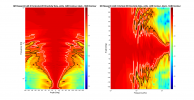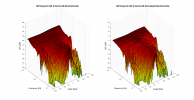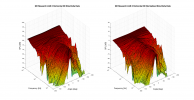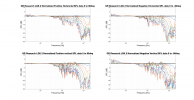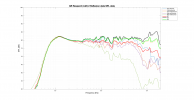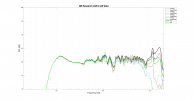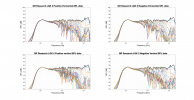This is a review and detailed measurements of the GR Research "Little Giant Killer" (LGK) 2.0 bookshelf speaker. It comes in various forms from a kit ($313) to fully finished pair ($1,038). Our DIY expert @Rick Sykora built my sample using the flatpack ($100):

Rick had to do the round over on the two edges per company recommendation as the flatpack is supplied with sharp edges. The build is superb and solid. Here is the back with the famous "tube connectors" and slot port:

Internal structure is complex due to that port so unless you are a serious woodworker, you need to get the flatpack.
The main driver is a tiny "full range" 3 inch unit. This allowed the cabinet to be small which I appreciated. Then again, there are plenty of active speakers which are the same size. Here is a comparison to the Neumann KH80DSP which sells for the same cost:

They are almost the same depth as well. Of course, the Neumann comes with built-in amplifier and DSP which the GLK 2.0 lacks.
Subjective claims in company video claims sound that is smooth and beats many larger speakers (hence the name).
You may be wondering by now why the title has the word "joke" in it. I reached out to company asking for a sample for review. Company owner, Danny Ritchie answered me saying he had no interest in providing me one. And that he and others think my reviews are a joke because I don't know how to listen to a speaker, don't have the right treated room, etc. On measurements he said he already provides them so nobody needs more information. I explained to him why his measurements are insufficient and again he repeated that nothing more is needed and that measurements like distortion are useless.
Anyway, we were then forced to purchase a pair for testing.
Measurements that you are about to see were performed using the Klippel Near-field Scanner (NFS). This is a robotic measurement system that analyzes the speaker all around and is able (using advanced mathematics and dual scan) to subtract room reflections (so where I measure it doesn't matter). It also measures the speaker at close distance ("near-field") which sharply reduces the impact of room noise. Both of these factors enable testing in ordinary rooms yet results that can be more accurate than an anechoic chamber. In a nutshell, the measurements show the actual sound coming out of the speaker independent of the room.
Reference axis is approximately the center of the tweeter.
GR Research LGK 2.0 Measurements
As usual we start with our "spin" graph:

At first this looks radically different than what the company shows:

I have circled some of the reasons the two graphs look different. Danny is using improper and heavy filtering (1/3 octave) for his measurements. This gets rid of the myriad of variations you see in my graph. He also uses gated response to get rid of room reflections which in the process removes any resolution below a few hundred Hertz. This is why his graph starts at 200 Hz rather than 20 Hz.
Rick was kind enough to post process mine to his resolution and chart dimensions and correlation was good.
Edit: here is that comparison:

Back to the spin, on-axis response look fairly flat. There is a notch where I think his baffle step loss filter is but is narrow so likely not audible. Overall, a good showing there.
Near-field response shows cabinet/port resonance interference:

The single driver is too large compared to a typical tweeter. This means that the sound starts to focus/beam as frequencies go up. This shows up in a number of measurements starting from early reflections in the form of high frequency loss:

Predicted in-room response (far field) as a result shows similar droop:

Still, this is a reasonable response.
Back to beaming, we see it clearly in the beam width and directivity plots:


The picture is nearly the same vertically due to use of a single driver:

So has the company cheated the laws of physics? Well, not quite. Let's look at distortion at 86 dBSPL:

Note: both left and right at the same graph at 86 dBSPL. Not 96 dB. Right one simply zooms out to show that distortion has risen to nearly 100%! Now, some of that is beyond the reach of the speaker but looking at the left graph we see that massive distortion reaches out to nearly 500 Hz. Second harmonic of that lands at 1 kHz where our hearing starts to become very sensitive. So bass distortion is likely quite audible.
Worried that it could not handle 96 dBSPL, I lowered the level to 90 dBSPL and ran the distortion test again:

Near the start of the sweep, speaker started to crackle which then went away above that frequency. Clearly it can't handle that but even 86 dBSPL is poor as I showed earlier.
Impedance is higher than average for the class which is good:

Something strange is going on as far as resonances though for the graph to become rough below 200 Hz. My measurements here are quite high resolution compared to what others run so this may not be visible in other people's tests.
Company shows a CSD/waterfall which looks clean. Mine does not:

Every peak in frequency response will cause time domain ringing which my display clear shows. I can however just change one number and get what the company shows:

Here is the company measurement:

What did I change? I moved up the bottom of the graph 4 dBSPL! This is why I say be careful with waterfall displays. It is so easy to lie with them. Or misuse them (intentionally or not).
Finally, here is the step response for fans of that:

EDIT:
Post review, I measured the electrical response of the filter network at the speaker terminals:

This very much matches the indicated goals for the filter network. As noted, the first filter is to bring down the levels due to baffle step rise. The second is a poor attempt at fixing a resonance in the driver:

The shape of irregularity from around 6K to nearly 200 kHz is way too complex for that simple notch filter. The filter is also too narrow to make much of an audible effect. High-q/narrow filters are also difficult to aim due to variability of parts/filter network. We see that here where the notch filter is higher than the frequency of interest.
For those of you who stop here and not read my subjective tests, I highly suggest that you make an exception and read on!
GR Research LGK 2.0 Listening Tests
I used my RME ADI-2 DAC as the source to drive a Topping PA5 which in turn powered the LGK 2.0. Listening setup was near-field.
By this time, I actually expected the speaker to sound good (based on spin data). Boy was that not the case. At any listening level above faint music, there would be this nasty warbling sound to vocals which would progressively get worse with volume. I am talking about way below the point where it crackles. The only time this was not super audible was if there was no bass at all. My female tracks are not bass heavy but the bit they had, caused this speaker distort so badly that it was unlistenable. I have tested over 200 speakers and never heard a speaker with such poor response.
By chance I had my desk lamp above it so could easily see the shadow of the driver below the cabinet. As soon as I would see any vibration in that shadow (due to the cone moving), the game was over. And again, this happened at very modest volumes with me sitting just 3 feet/1 meter away from the speaker!
Suspect bass being the problem, I took out the EQ tool and put in a sharp high pass:

This managed to get rid of significant amount of that warbling effect. But then there was so little bass that one was left thinking the sound was just too thin. That aside though, the tonality now shone through and I had little to complain about in that department. I did put a bit of the boost where that notch is and thought it improved the response subtly. To aid more in power handling I also pulled down that bass hump. This helped a bit more but now I had so little bass.
With the EQ in place, I could play at modest levels but sound was boring, and distortion still present. Unless you were playing something that as instrumental/higher in frequency range, nothing sounded clean and without distortion.
Conclusions
Ah, little giant killers... who doesn't want to see an underdog win? Put in a spokesman in front of the camera that tells the nice story and you just want to believe it. I know I believed it a lot more than what I experienced with the speaker. Yes, the tonality is good overall. No, you can't take a midrange+tweeter driver and pretend it can play bass at the same time. It simply cannot. How on earth anyone can say this speaker is usable let alone high-fi is beyond me.
Is Danny this oblivious to distortion? This is not subtle stuff folks. Measurements show extreme amount of distortion and listening tests easily bring out the same. And of course physics solidly predicts it as well.
There is a reason my acoustic measurements from day one have included distortion measurements. And why I listen for dynamic behavior in my listening tests. Hi-fi is about enjoyment and there, you want to have some volume. The LGK 2.0 simply cannot go there. The driver seems to be designed for a boombox or something with matching electronics to control what it can or cannot do. Sticking it in a box and calling it great is one of the biggest farces I have seen in audio business!
I know some may say I am biased to not like GR Research stuff. But I have given positive marks to another speaker kit of his. Importantly, I back my opinion with measurements and science/engineering of the design, not empty boasting. All the arrows point to the same thing. This speaker is simply a bad idea. Had the company spent time measuring distortion and getting feedback from others with better hearing, they would have no doubt gotten the feedback that the design was not feasible.
Yes, the tonality is good but without dynamics of any nature, it is a useless attempt.
For the same cost as these finished, you have tons and tons of choices of speakers including the aforementioned Neumann which runs over this speaker as if it is not there. I don't see the angle of "DIY" here either. Gluing a flatpack is not going to give you much satisfaction when the finished performance is this horrid. If you want to do that, build a larger speaker with proper design. This dog simply don't hunt.
Needless to say, I can't recommend the GR Research LGK 2.0. As I noted, it is the worse speaker I have heard.
Edit: video review also posted:
-----------
As always, questions, comments, recommendations, etc. are welcome.
Any donations are much appreciated using: https://www.audiosciencereview.com/forum/index.php?threads/how-to-support-audio-science-review.8150/
Rick had to do the round over on the two edges per company recommendation as the flatpack is supplied with sharp edges. The build is superb and solid. Here is the back with the famous "tube connectors" and slot port:
Internal structure is complex due to that port so unless you are a serious woodworker, you need to get the flatpack.
The main driver is a tiny "full range" 3 inch unit. This allowed the cabinet to be small which I appreciated. Then again, there are plenty of active speakers which are the same size. Here is a comparison to the Neumann KH80DSP which sells for the same cost:
They are almost the same depth as well. Of course, the Neumann comes with built-in amplifier and DSP which the GLK 2.0 lacks.
Subjective claims in company video claims sound that is smooth and beats many larger speakers (hence the name).
You may be wondering by now why the title has the word "joke" in it. I reached out to company asking for a sample for review. Company owner, Danny Ritchie answered me saying he had no interest in providing me one. And that he and others think my reviews are a joke because I don't know how to listen to a speaker, don't have the right treated room, etc. On measurements he said he already provides them so nobody needs more information. I explained to him why his measurements are insufficient and again he repeated that nothing more is needed and that measurements like distortion are useless.
Anyway, we were then forced to purchase a pair for testing.
Measurements that you are about to see were performed using the Klippel Near-field Scanner (NFS). This is a robotic measurement system that analyzes the speaker all around and is able (using advanced mathematics and dual scan) to subtract room reflections (so where I measure it doesn't matter). It also measures the speaker at close distance ("near-field") which sharply reduces the impact of room noise. Both of these factors enable testing in ordinary rooms yet results that can be more accurate than an anechoic chamber. In a nutshell, the measurements show the actual sound coming out of the speaker independent of the room.
Reference axis is approximately the center of the tweeter.
GR Research LGK 2.0 Measurements
As usual we start with our "spin" graph:
At first this looks radically different than what the company shows:
I have circled some of the reasons the two graphs look different. Danny is using improper and heavy filtering (1/3 octave) for his measurements. This gets rid of the myriad of variations you see in my graph. He also uses gated response to get rid of room reflections which in the process removes any resolution below a few hundred Hertz. This is why his graph starts at 200 Hz rather than 20 Hz.
Rick was kind enough to post process mine to his resolution and chart dimensions and correlation was good.
Edit: here is that comparison:
Back to the spin, on-axis response look fairly flat. There is a notch where I think his baffle step loss filter is but is narrow so likely not audible. Overall, a good showing there.
Near-field response shows cabinet/port resonance interference:
The single driver is too large compared to a typical tweeter. This means that the sound starts to focus/beam as frequencies go up. This shows up in a number of measurements starting from early reflections in the form of high frequency loss:
Predicted in-room response (far field) as a result shows similar droop:
Still, this is a reasonable response.
Back to beaming, we see it clearly in the beam width and directivity plots:
The picture is nearly the same vertically due to use of a single driver:
So has the company cheated the laws of physics? Well, not quite. Let's look at distortion at 86 dBSPL:
Note: both left and right at the same graph at 86 dBSPL. Not 96 dB. Right one simply zooms out to show that distortion has risen to nearly 100%! Now, some of that is beyond the reach of the speaker but looking at the left graph we see that massive distortion reaches out to nearly 500 Hz. Second harmonic of that lands at 1 kHz where our hearing starts to become very sensitive. So bass distortion is likely quite audible.
Worried that it could not handle 96 dBSPL, I lowered the level to 90 dBSPL and ran the distortion test again:
Near the start of the sweep, speaker started to crackle which then went away above that frequency. Clearly it can't handle that but even 86 dBSPL is poor as I showed earlier.
Impedance is higher than average for the class which is good:
Something strange is going on as far as resonances though for the graph to become rough below 200 Hz. My measurements here are quite high resolution compared to what others run so this may not be visible in other people's tests.
Company shows a CSD/waterfall which looks clean. Mine does not:
Every peak in frequency response will cause time domain ringing which my display clear shows. I can however just change one number and get what the company shows:
Here is the company measurement:

What did I change? I moved up the bottom of the graph 4 dBSPL! This is why I say be careful with waterfall displays. It is so easy to lie with them. Or misuse them (intentionally or not).
Finally, here is the step response for fans of that:
EDIT:
Post review, I measured the electrical response of the filter network at the speaker terminals:
This very much matches the indicated goals for the filter network. As noted, the first filter is to bring down the levels due to baffle step rise. The second is a poor attempt at fixing a resonance in the driver:

The shape of irregularity from around 6K to nearly 200 kHz is way too complex for that simple notch filter. The filter is also too narrow to make much of an audible effect. High-q/narrow filters are also difficult to aim due to variability of parts/filter network. We see that here where the notch filter is higher than the frequency of interest.
For those of you who stop here and not read my subjective tests, I highly suggest that you make an exception and read on!
GR Research LGK 2.0 Listening Tests
I used my RME ADI-2 DAC as the source to drive a Topping PA5 which in turn powered the LGK 2.0. Listening setup was near-field.
By this time, I actually expected the speaker to sound good (based on spin data). Boy was that not the case. At any listening level above faint music, there would be this nasty warbling sound to vocals which would progressively get worse with volume. I am talking about way below the point where it crackles. The only time this was not super audible was if there was no bass at all. My female tracks are not bass heavy but the bit they had, caused this speaker distort so badly that it was unlistenable. I have tested over 200 speakers and never heard a speaker with such poor response.
By chance I had my desk lamp above it so could easily see the shadow of the driver below the cabinet. As soon as I would see any vibration in that shadow (due to the cone moving), the game was over. And again, this happened at very modest volumes with me sitting just 3 feet/1 meter away from the speaker!
Suspect bass being the problem, I took out the EQ tool and put in a sharp high pass:
This managed to get rid of significant amount of that warbling effect. But then there was so little bass that one was left thinking the sound was just too thin. That aside though, the tonality now shone through and I had little to complain about in that department. I did put a bit of the boost where that notch is and thought it improved the response subtly. To aid more in power handling I also pulled down that bass hump. This helped a bit more but now I had so little bass.
With the EQ in place, I could play at modest levels but sound was boring, and distortion still present. Unless you were playing something that as instrumental/higher in frequency range, nothing sounded clean and without distortion.
Conclusions
Ah, little giant killers... who doesn't want to see an underdog win? Put in a spokesman in front of the camera that tells the nice story and you just want to believe it. I know I believed it a lot more than what I experienced with the speaker. Yes, the tonality is good overall. No, you can't take a midrange+tweeter driver and pretend it can play bass at the same time. It simply cannot. How on earth anyone can say this speaker is usable let alone high-fi is beyond me.
Is Danny this oblivious to distortion? This is not subtle stuff folks. Measurements show extreme amount of distortion and listening tests easily bring out the same. And of course physics solidly predicts it as well.
There is a reason my acoustic measurements from day one have included distortion measurements. And why I listen for dynamic behavior in my listening tests. Hi-fi is about enjoyment and there, you want to have some volume. The LGK 2.0 simply cannot go there. The driver seems to be designed for a boombox or something with matching electronics to control what it can or cannot do. Sticking it in a box and calling it great is one of the biggest farces I have seen in audio business!
I know some may say I am biased to not like GR Research stuff. But I have given positive marks to another speaker kit of his. Importantly, I back my opinion with measurements and science/engineering of the design, not empty boasting. All the arrows point to the same thing. This speaker is simply a bad idea. Had the company spent time measuring distortion and getting feedback from others with better hearing, they would have no doubt gotten the feedback that the design was not feasible.
Yes, the tonality is good but without dynamics of any nature, it is a useless attempt.
For the same cost as these finished, you have tons and tons of choices of speakers including the aforementioned Neumann which runs over this speaker as if it is not there. I don't see the angle of "DIY" here either. Gluing a flatpack is not going to give you much satisfaction when the finished performance is this horrid. If you want to do that, build a larger speaker with proper design. This dog simply don't hunt.
Needless to say, I can't recommend the GR Research LGK 2.0. As I noted, it is the worse speaker I have heard.
Edit: video review also posted:
-----------
As always, questions, comments, recommendations, etc. are welcome.
Any donations are much appreciated using: https://www.audiosciencereview.com/forum/index.php?threads/how-to-support-audio-science-review.8150/
Attachments
Last edited:


